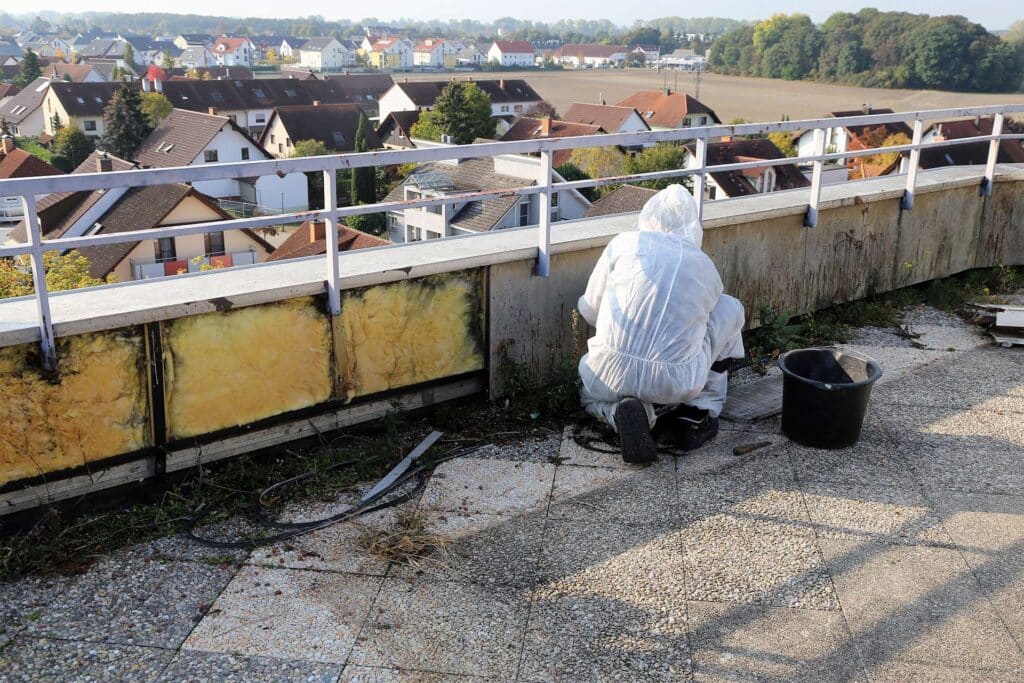ALL CLEAR SERVICES
All About Asbestos
Asbestos is a naturally forming mineral called Hydrous Magnesium Silicates, whose fibres have various negative effects on people who inadvertently inhale them. Mainly mined and imported from Canada and South Africa, it used to be a popular building material with contractors in the United Kingdom, on account of its more durable properties. Prior to new legislation introduced in the year 2000, approximately 5 million tonnes were imported into the UK and used extensively in more than 500,000 buildings. In many cases and products, asbestos remains in a good condition for decades. By learning more about asbestos, you will know what to be wary of in your working environment.

Types of Asbestos
Although the various asbestos types are commonly referred to by colour, this does not prove an ideal way to identify the material and microscopic investigation is recommended by the accredited surveyors and laboratories. There are 3 main commonly known types of asbestos:
commonly known as white asbestos. Used primarily in cement products and other various materials and papers.
commonly known as brown asbestos. Typically used in pipe insulation and lagging applications or mixed with other materials to form asbestos insulation board (AIB).
commonly known as blue asbestos. Typically used within sprayed coatings and insulation and referred to as the most dangerous of the three.
Working with Asbestos
It’s important to observe some basic safety do’s and don’ts when working in environments where you might be exposed to asbestos.
Don’t:
- Use Methods or Equipment That Create a Lot of Dust, such as Power Tools
- Sweep up Dust and Debris – Use a Type H Vacuum Cleaner or Wet Rags
- Take Home Overalls Used for Asbestos Work
- Re-Use Disposable Clothing or Masks
- Smoke, Eat, or Drink in the Work Area
Do:
- Stop and Ask If You Are Suspicious That Something May Be Asbestos, or If You Think the Work Might Require a Licenced Contractor
- Follow the Plan of Work and Task Guidance Sheets – Make Sure You Use the Right Sheet for the Job
- Take Account of Other Risks, such as Work at Height
- Use Your Protective Equipment, including a Suitable Face Mask, Worn Properly
- Clean up as You Go in Order to Prevent Waste Build-ups
- Make Sure Waste is Double-Bagged and Disposed of Properly
- Wash before Breaks and Going Home
Why Is It Dangerous?
In Great Britain, asbestos fibres are present in the environment, but people are usually exposed to very low levels of fibres. However, a key factor in the risk of developing an asbestos-related disease is the total number of fibres breathed in.
While working on or near damaged asbestos-containing materials, you’ll be exposed to many hundreds of times more fibres than in a standard environment. This increases your risk of inhaling high levels of fibres and contracting an asbestos-related disease. These diseases kill more than 4,000 people every year in the UK alone.
There are four main diseases caused by asbestos:
- Mesothelioma (Which Is Always Fatal)
- Lung Cancer (Almost Always Fatal)
- Asbestosis (Not Always Fatal, but Very Debilitating)
- Diffuse Pleural Thickening (Not Fatal)
Remember, these diseases will not affect you immediately but later on in life, so you need to protect yourself now, in order to avoid contracting an asbestos-related disease in the future. It is also important to remember that people who smoke and are also exposed to asbestos fibres are at a much greater risk of developing lung cancer.


When Am I at Risk?
You are mostly at risk when:
- Working on an Unfamiliar Site, or a Building Constructed prior to 2000
- Asbestos-Containing Materials Are Not Identified to Workers prior to Commencement of Work
- Asbestosis (You or Your Co-Workers Fail to Learn or Adhere to the Proper Safety Procedures and Precautions
As long as the asbestos is not damaged or located somewhere where it can be easily damaged it won’t be a risk to you. Remember:
- You Can’t See or Smell Asbestos Fibres in the Air
- The Effects of Asbestos Take Many Years to Appear – Avoid Inhaling It Now
- Smoking Increases the Risk Many Times
- Asbestos Is Only a Danger When Fibres Are Made Airborne
Where Can You Find It?
Due to its popularity in the UK construction industry, asbestos cement can be found in many different places, including articles such as water tanks, fire surrounds, and pipes. Other common places include:
These are mainly made up of large sheets of corrugated asbestos cement; they are often found on industrial or farmyard buildings, but also can be found as roofs on garages and sheds. They are usually covered in mosses as they’ve been there for many years.
Shape and structure similar to roof sheeting, this is often found on walls or as walls of buildings with asbestos cement roofs.
Sometimes attached at the end of cement roofs in warehouse type buildings.
Including domestic properties, this may be found in boiler systems and air conditioning and ventilation systems.
Also including:
Pipe Insulation
Asbestos Insulation Board
Sprayed Coating
Lagging
What Does It Look Like?
Asbestos cement is just ordinary cement mixed with asbestos. In some cases, asbestos can make up over a third of the cement. It is a hard, grey material which was moulded and compressed to produce some of the materials listed above.



